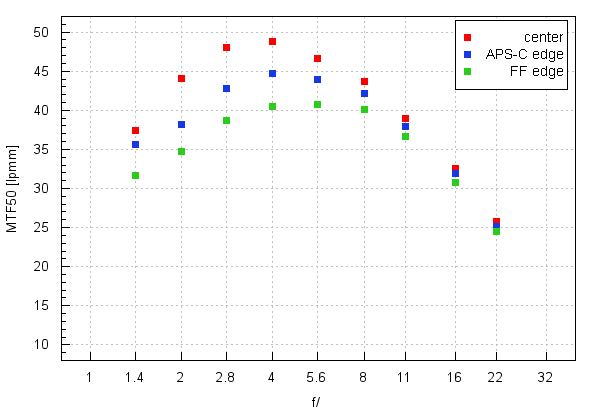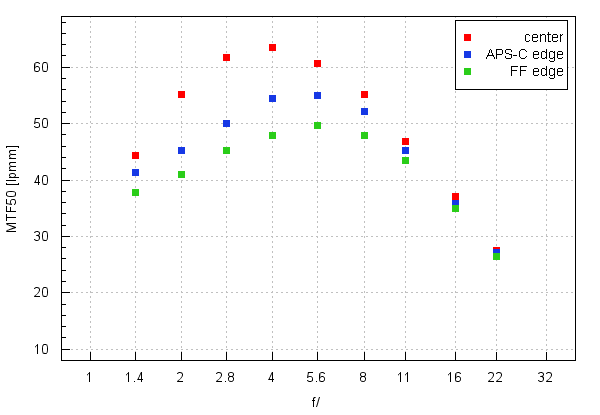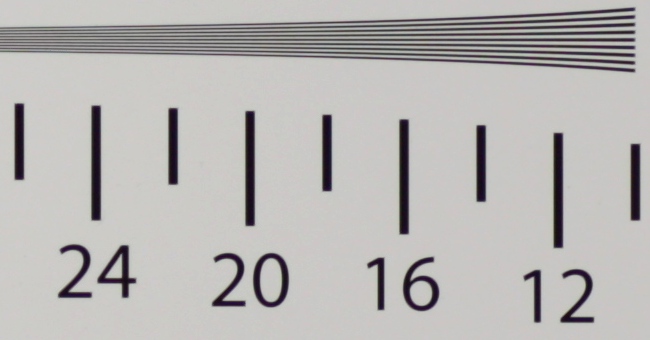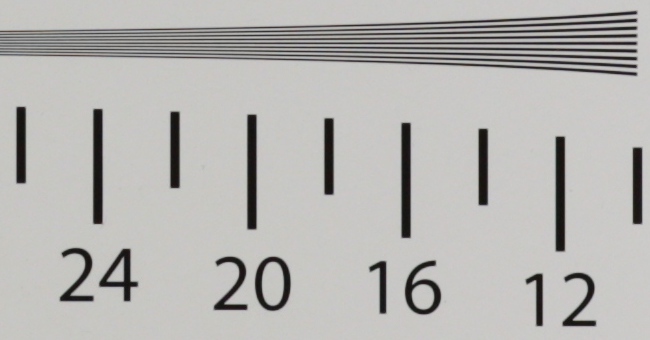Canon EF 85 mm f/1.4L IS USM
4. Image resolution
Let’s check how the results of the Canon 1.4/85 IS compare here – a graph below presents its resolution levels in the frame centre, on the edge of the APS-C/DX and on the edge of full frame.

Please Support UsIf you enjoy our reviews and articles, and you want us to continue our work please, support our website by donating through PayPal. The funds are going to be used for paying our editorial team, renting servers, and equipping our testing studio; only that way we will be able to continue providing you interesting content for free. |
- - - - - - - - - - - - - - - - - - - - - - - - - - - - - - - - - - - - - - - - - - - - - - - -
Generally speaking it would be difficult to complain at all. In the frame centre you get a value of over 37 lpmm already at the maximum relative aperture so you can produce images of good quality. What’s more, these values are a tad higher than the ones produced by the Zeiss Milvus 1.4/85. On stopping down the aperture the image quality improves and it reaches its peak of 48 lpmm by f/4.0. It is a bit lower than in the case of the Milvus but both values are similar within the margin of error. The Zeiss Otus 1.4/85 fared even better but that lens belongs to a quite different price-point so it would be hard to call it a direct rival of the tested lens. Such a performance would be very favourable for the Canon but the positive image is destroyed by the Sigma A 85 mm f/1.4 DG HSM. The Sigma is cheaper than the Canon but its performance is better both at the maximum relative aperture and on stopping down. The biggest difference you can spot near f/2.0 where the Sigma is able to reach close to 50 lpmm and the Canon barely exceeds 44 lpmm.
The distinct advantage of the Sigma can also be noticed on the edge of the APS-C sensor where, even at the maximum relative aperture, that lens was able to exceed 40 lpmm and on stopping down its resolution level was higher than 46 lpmm. The Canon performs much worse but it hardly means weak results per se, quite the opposite is true. The Canon fares better than the Zeiss Milvus and is overall a very sharp lens. The Sigma simply raised the standards to an unbelievably high level.
Most of reservations you can have after analyzing the performance on the very edge of full frame. Perhaps there are no distinct weak points there, because even at the maximum relative aperture the image quality remains acceptable, but in this case the Canon lags distinctly behind the Sigma and the Milvus, taking firmly the third place.
In commentaries on our tests and in e-mails we get from our Optyczne.pl and LensTip.com Readers we are sometimes asked why we still test full frame lenses on old 21-24 Mpix sensors which aren’t as demanding as new 40-50 Mpix ones. I’ve read suggestions that if we switched to sensors more densely packed with pixels our resolution tests results would be more reliable. I don’t completely agree with that opinion; newer autofocus units, which would allow to assess the performance of the camera plus the lens set better, would be, in my view, the only argument that might persuade me to use newer bodies during the tests. When it comes to the lens resolution alone, even such cameras as the Canon EOS 5D Mark III and the Nikon D3x make it possible to draw binding conclusions. Do you need proof? Very well, here it goes.
Below you see a graph with the resolution results of the Canon EF 85 mm f/1.4L IS USM tested on the Canon EOS 5Ds with a 50 Mpix detector.

A king’s ransom to whoever can draw more information out of that graph than out of the one based on the Canon 5D Mark III, presented earlier. The results at the maximum relative aperture are still safely above the decency level (which, provisionally, we can set at the same level as the MTFs you get by f/16), and the maximum results of almost 64 lpmm we once again get by f/4.0. It is a high value but hardly a record-breaking one because the best fixed-focal lenses on the 5Ds are able to get to a level of 66-67 lpmm so they are by several percent better. Isn’t it exactly the same conclusion as the one we drew from the data produced by the Canon 5D Mark III?
So, are we going to move to more densely packed sensors any time soon? To be honest I don’t know. Newer models tempt us with better autofocus and other novelties but such a change would also mean the loss of priceless opportunity to compare any new lens test with a whole gamut of older tests already published on our website. Compiling a new database would take some time.
At the end, traditionally, we present crops taken from photos of our resolution testing chart saved as JPEG files.
| Canon 5D MkIII, JPEG, 85 mm, f/1.4 |
 |
| Canon 5D MkIII, JPEG, 85 mm, f/4.0 |
 |






